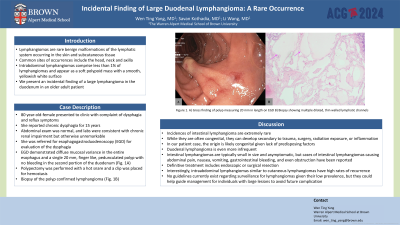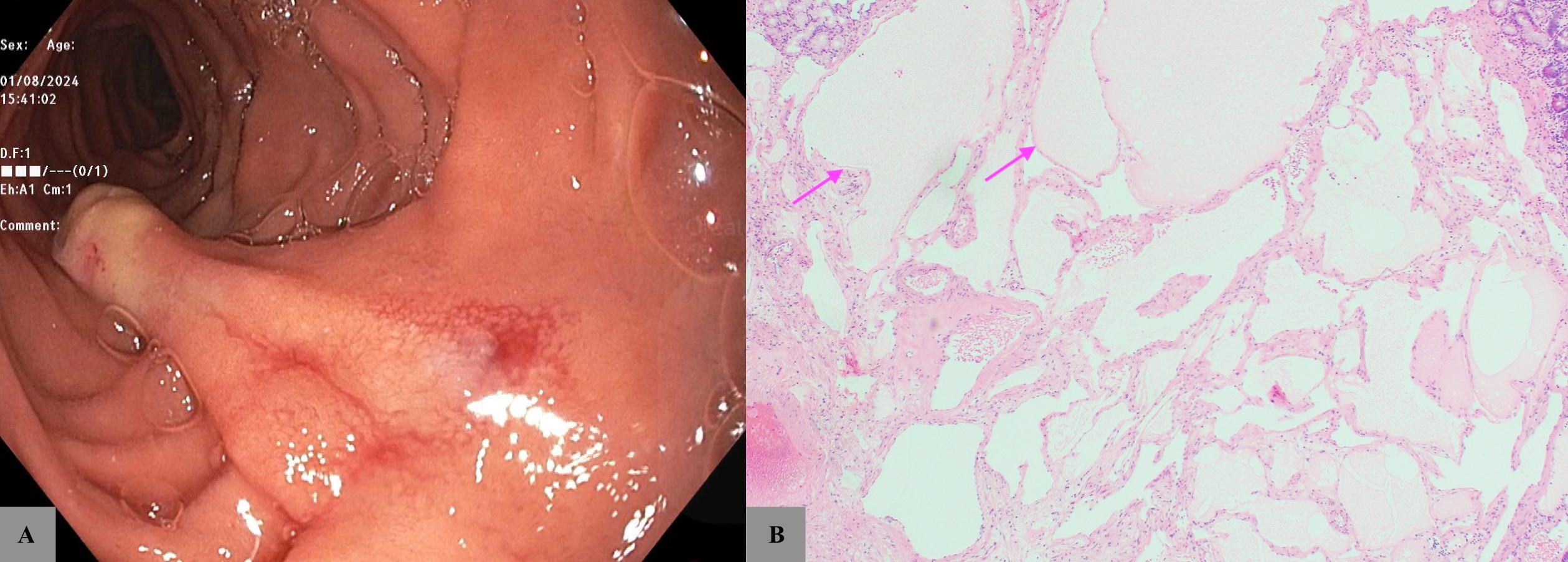Tuesday Poster Session
Category: Small Intestine
P5027 - Incidental Finding of Large Duodenal Lymphangioma: A Rare Occurrence
Tuesday, October 29, 2024
10:30 AM - 4:00 PM ET
Location: Exhibit Hall E

Has Audio
- WY
Wen Ting Yang, MD
Brown University / Rhode Island Hospital
Providence, RI
Presenting Author(s)
Wen Ting Yang, MD1, Savan Kothadia, MD2, Li Wang, MD3
1Brown University / Rhode Island Hospital, Providence, RI; 2The Warren Alpert Medical School of Brown University, Providence, RI; 3Brown Medicine/Brown Physicians, Inc., Providence, RI
Introduction: Lymphangiomas are rare benign malformations of the lymphatic system occurring in the skin and subcutaneous tissue. Although they can arise in any body organ, common sites of occurrences include the head, neck and axilla. Intra-abdominal lymphangiomas comprise less than 1% of lymphangiomas and appear as a soft polypoid mass with a smooth, yellowish white surface. We present an incidental finding of a large lymphangioma in the duodenum of an older adult patient.
Case Description/Methods: 80 year-old-female presented to clinic with concerns of dysphagia and reflux symptoms for 15 years. Abdominal exam was normal, and labs were consistent with chronic renal impairment but otherwise unremarkable. She was referred for esophagogastroduodenoscopy (EGD) for evaluation. EGD demonstrated a single 22 mm, finger-like, polypoid lesion without bleeding in the second portion of the duodenum (Fig. 1A). The lesion was removed with a hot snare and a clip was placed for hemostasis. Histopathology confirmed the lesion was a lymphangioma (Fig. 1B).
Discussion: This case demonstrates a rare incidentally found large duodenal lymphangioma. While they are often congenital, they can develop secondary to trauma, surgery, radiation exposure, or inflammation. In this case, the origin is likely congenital given lack of predisposing factors. Intestinal lymphangiomas are extremely rare, with duodenal involvement being even more infrequent. They are typically small in size and asymptomatic, but cases of intestinal lymphangiomas causing abdominal pain, nausea, vomiting, gastrointestinal bleeding, and even obstruction have been reported. Definitive treatment includes endoscopic or surgical resection; however, similar to cutaneous lymphangiomas, intra-abdominal lymphangiomas have high rates of recurrence. No guidelines currently exist regarding surveillance for lymphangiomas given their low prevalence, but could help guide management for individuals with large lesions to avoid potential future complications.

Disclosures:
Wen Ting Yang, MD1, Savan Kothadia, MD2, Li Wang, MD3. P5027 - Incidental Finding of Large Duodenal Lymphangioma: A Rare Occurrence, ACG 2024 Annual Scientific Meeting Abstracts. Philadelphia, PA: American College of Gastroenterology.
1Brown University / Rhode Island Hospital, Providence, RI; 2The Warren Alpert Medical School of Brown University, Providence, RI; 3Brown Medicine/Brown Physicians, Inc., Providence, RI
Introduction: Lymphangiomas are rare benign malformations of the lymphatic system occurring in the skin and subcutaneous tissue. Although they can arise in any body organ, common sites of occurrences include the head, neck and axilla. Intra-abdominal lymphangiomas comprise less than 1% of lymphangiomas and appear as a soft polypoid mass with a smooth, yellowish white surface. We present an incidental finding of a large lymphangioma in the duodenum of an older adult patient.
Case Description/Methods: 80 year-old-female presented to clinic with concerns of dysphagia and reflux symptoms for 15 years. Abdominal exam was normal, and labs were consistent with chronic renal impairment but otherwise unremarkable. She was referred for esophagogastroduodenoscopy (EGD) for evaluation. EGD demonstrated a single 22 mm, finger-like, polypoid lesion without bleeding in the second portion of the duodenum (Fig. 1A). The lesion was removed with a hot snare and a clip was placed for hemostasis. Histopathology confirmed the lesion was a lymphangioma (Fig. 1B).
Discussion: This case demonstrates a rare incidentally found large duodenal lymphangioma. While they are often congenital, they can develop secondary to trauma, surgery, radiation exposure, or inflammation. In this case, the origin is likely congenital given lack of predisposing factors. Intestinal lymphangiomas are extremely rare, with duodenal involvement being even more infrequent. They are typically small in size and asymptomatic, but cases of intestinal lymphangiomas causing abdominal pain, nausea, vomiting, gastrointestinal bleeding, and even obstruction have been reported. Definitive treatment includes endoscopic or surgical resection; however, similar to cutaneous lymphangiomas, intra-abdominal lymphangiomas have high rates of recurrence. No guidelines currently exist regarding surveillance for lymphangiomas given their low prevalence, but could help guide management for individuals with large lesions to avoid potential future complications.

Figure: Figure 1. A) Gross finding of polyp measuring 22 mm in length on EGD B) Histopathology showing multiple dilated, thin-walled lymphatic channels
Disclosures:
Wen Ting Yang indicated no relevant financial relationships.
Savan Kothadia indicated no relevant financial relationships.
Li Wang: Eli Lilly – Stock-publicly held company(excluding mutual/index funds). Moderna – Stock-publicly held company(excluding mutual/index funds).
Wen Ting Yang, MD1, Savan Kothadia, MD2, Li Wang, MD3. P5027 - Incidental Finding of Large Duodenal Lymphangioma: A Rare Occurrence, ACG 2024 Annual Scientific Meeting Abstracts. Philadelphia, PA: American College of Gastroenterology.
